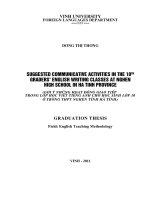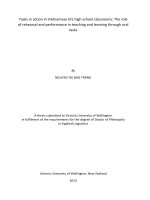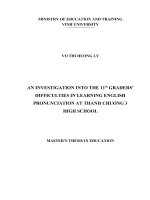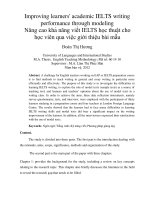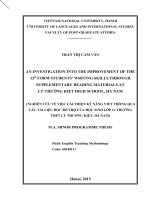IMPROVING THE 11TH GRADERS’ ENGLISH WRITING PERFORMANCE THROUGH PROJECT – BASED LEARNING
Bạn đang xem bản rút gọn của tài liệu. Xem và tải ngay bản đầy đủ của tài liệu tại đây (2.38 MB, 136 trang )
MINISTRY OF EDUCATION AND TRAINING
VINH UNIVERSITY
NGUYEN THI HUONG
IMPROVING THE 11TH GRADERS’ ENGLISH WRITING
PERFORMANCE THROUGH PROJECT – BASED LEARNING
MASTER’S THESIS IN EDUCATION
Nghe An, 2017
MINISTRY OF EDUCATION AND TRAINING
VINH UNIVERSITY
NGUYEN THI HUONG
IMPROVING THE 11TH GRADERS’ ENGLISH WRITING
PERFORMANCETHROUGH PROJECT – BASED LEARNING
Major: Teaching English to Speakers of Other Languages(TESOL)
Code: 60140111
MASTER’S THESIS IN EDUCATION
SUPERVISOR
Tran Ba Tien, Ph.D.
Nghe An, 2017
AKNOWLEDGEMENTS
I would like to express my deepest gratitude to my thesis supervisor, Ph. D.
Tran Ba Tien for his whole-hearted guidance, valuable comments, and support in the
preparation and completion of this thesis.
My special thanks go to the organizers of this master course, especially Mr.
Ngo Dinh Phuong, vice director of Vinh University and I wish to thank all staff
members at Department of foreign languages for their help and moral support. I am
also grateful to all students who are fully completed the questionnaires and sincerely
provided me with valuable information for this study. Without their participation and
support, this thesis would never have come into existence.
Last, but not least, I express my thanks to my husband and all my friends who
have continually encouraged me to complete my study.
i
TABLE OF CONTENTS
ACKNOWLEDGEMENT…......................................................................
.
TABLE OF CONTENTS............................................................................
LIST OF TABLES.....................................................................................
LIST OF FIGURES.....................................................................................
LIST OF APPENDIXES.............................................................................
ABSTRACT…............................................................................................
i
ii
v
vi
vii
viii
Chapter 1:
INTRODUCTION
1.1.
1.2.
1.3.
1.4.
1.5.
1.6.
Rationale .........................................................................................
Aims of the research.......................................................................
The significance of the research.....................................................
The scope of the research................................................................
The research questions....................................................................
The organization of the research.....................................................
Chapter 2
1
2
3
3
3
3
LITERATURE REVIEW
2.1.
2.1.1.
2.1.2.
2.1.3.
2.1.4.
2.1.5.
2.1.6.
2.1.7.
2.1.8.
2.1.9.
2.1.10
2.2.
2.2.1.
2.2.2.
2.2.3.
2.2.4.
The nature of writing..................................................................
The definition of writing.............................................................
The characteristics of written language.......................................
Sub – skills of writing.................................................................
The process of writing.................................................................
Strategies in teaching writing......................................................
Types of classroom writing performance....................................
Principles of teaching
writing .....................................................
Teaching writing in high school..................................................
Accessing writing ......................................................................
Feedbach on writing....................................................................
Project – based
learning..............................................................
The definition of project – based learning...................................
The characteristics of project – based learning...........................
The significance of using project – based learning.....................
2.2.5. The steps of conducting project – based learning in a language
2.3.
lassroom.........................................................................................
5
5
6
7
9
11
12
13
14
16
17
18
18
19
21
22
24
25
2.4.
The role of the teachers and students in project – base learning. 26
Relevant studies...........................................................................
Conceptual framework...............................................................
ii
Chapter 3
METHODOLOGY
3.1.
3.2.
3.3.
3.4.
3.4.1.
3.4.2.
3.4.3.
3.5.
3.6.
Research methods.....................................................................
Setting of the research...............................................................
Subjects of the research...........................................................
Data collection and data analysis technique...........................
Perception questionaires ...........................................................
Classroom observation...............................................................
Written tests...............................................................................
The techniques of the data analysis........................................
The research process..........................................................
Chapter 4
29
29
30
30
30
31
32
32
33
FINDINGS AND DISCUSSION
4.1.
4.1.1.
4.1.2.
4.1.3.
4.1.4.
4.1.4.1.
4.1.4.2.
4.2.
4.2.1.
4.2.2.
4.2.3.
4.2.4.
4.2.4.1.
1)
2)
3)
4)
4.2.4.2.
Results of studentss perception toward project – based
learning approach……………………………………….
Benefits of project – based learning approach.....................
Students’ autonomy..............................................................
Students’ teamwork..............................................................
Discussion............................................................................
Students’ perception toward the project – based learnin...
Students’ perception toward teamwork..............................
Results of improvement in students’ writing
performance..........................................................................
Identification of the field problems .....................................
Determining the problems....................................................
Determining the actions to overcome the problems.............
Research process and results................................................
Report of cycle 1................................................................
Planning..................................................................................
Actions and observation.........................................................
Reflection...............................................................................
Findings of cycle 1.................................................................
Report of cycle 2....................................................................
35
35
36
38
39
39
40
43
43
45
47
48
48
48
49
56
60
61
1)
2)
3)
4)
4.2.5.
4.2.5.1.
4.2.5.2.
4.2.5.3.
Planning.................................................................................
Actions and observation.........................................................
Reflection...............................................................................
Findings of cycle 2................................................................
Discussion............................................................................
The design of actions in cycle 1........................................
The design of actions in cycle 2.........................................
The students’ score...........................................................
61
62
67
71
74
74
75
76
Iii
Chapter 5
CONCLUSIONS, IMPLICATIONS AND SUGGESTIONS
5.1.
Conclusions.................................................................................
5.2.
.
5.2.1. Implications................................................................................
5.2.2. Implications for the English teachers.........................................
5.2.3. Implications for the students.......................................................
5.3.
Implications for the other researchers........................................
Suggestionsfor further studies...................................................
79
80
80
80
81
81
REFERENCES...................................................................................................83
APPENDIXES…................................................................................................86
iv
LIST OF TABLES
Table 4.1: Questionnaires items on students’ attitude toward project –
based
35
learning............................................................................................
36
Table 4.2: Questionnaires items on students’ autonomy..............................................
39
Table 4.3: Questionnaires items on students’ teamwork..............................................
44
Table 4.4: A sample of students’ writing in the pretest................................................
44
Table 4.5: Another sample of student’s wrting in the pretest.......................................
45
Table 4.6: The pretest mean scores of each writing aspect..........................................
46
Table 4.7: Problems found at class 11A4 of Nong Cong 2 high
47
school.......
49
Table 4.8: The actions implemented to solve the
problem...........................
58
Table 4.9: The action plan and the expected improvement to achve...........................
59
Table 4.10: The mean score of cycle 1 test for five aspects of text
60
writing..................................................................................................
69
Table 4.11: The sample of students’ writing on cycle 1...............................................
69
Table 4.12: The comparison between before and after implementation of
71
Research.............................................................................................
Table 4.13: The students’ end product of cycle 2........................................................
71
Table 4.14: Another students’ end product of cycle 2..................................................
Table 4.15: The mean score of Cycle 2 test for five aspects of
77
writing
performance...........................................................................
77
Table 4.16: The change results of the improvement of the actions during
the teaching and learnign
process.......................................................
Table 4.17: The results of Pre and Post test in Cycle 1 and Cycle 2.
paired single
statistic ..........................................................................
Table 4.18: The details Quantive analysis of the Pre and Post test.
paired single
Correlations...................................................................
v
LIST OF FIGURES
Figure 1: The chart of writing process ....................................................................10
Figure 2: The students’ project in cycle 1................................................................58
Figure 3: Students do project work in group ..........................................................68
Figure 4: The chart of the mean of the test scores for five aspects of writing texg..76
Figure 5: The results of Pre and Post – test in Cycle 1 and Cycle 2 in mean scores 78
vi
LIST OF APPENDICES
Appendix 1: Course Grids.........................................................................................86
Appendix 2: Questionnaires for students ................................................................94
Appendix 3: Observation Checklist.........................................................................101
Appendix 4: Writing Assessment Rubric.................................................................103
Appendix 5: The samples of Students’ Writing.......................................................105
Appendix 6: Students’ Score...................................................................................108
Appendix 7: Photographs........................................................................................118
vii
ABSTRACT
The aim of this research was to improve the writing skills of 11 th graders
at Nong Cong 2 High School through project-based learning. It was expected that
project-based learning could be used to improve the students writing skills of 11th
graders at Nong Cong 2 High School.
This research was classified as action research. It was conducted in two
cycles. The main subjects of this research were 50 students of class 11A4 at Nong
Cong 2 High School. The data obtained were qualitative and quantitative. The
qualitative data were gained from the questionnaires, writing tests and observation
with the students. Meanwhile, the quantitative data were gained from the writing tests
that were conducted before the action implementation and at the end of every cycle.
There were several validity principles applied in this research; they were democratic
validity, outcome validity, process validity, catalytic validity, and dialogic validity.
Furthermore, to test the trustworthiness these three triangulation principles were
implemented: time triangulation, space triangulation, and investigator triangulation.
The results of this research showed that the implementation of projectbased learning in the English teaching and learning process was able to improve the
students’ writing abilities. Project-based learning can develop students’ motivation in
learning the language. It also provided feedback for them. The various activities
employed in PBL facilitated the students to understand the lesson more easily. The
group work conducted during the implementation of project-based learning gave
positive impact to the students’ involvement and participation. The students made
good improvements in text organization, content, grammar, vocabulary and
mechanics. Moreover, the mean of the students’ writing score in the pretest was 4.73
meanwhile that in the post-test was 7.31. The improvement by 2.58 is significant
according to the t-test. The standard deviation of the students’ scores in the pretest
was 0.903935 while that in the post-test was 0.773886
viii
Chapter 1
INTRODUCTION
1.1.
Rationale
Nowadays, English has become a means of international communication and
one of the most popular languages in the world. It is used for almost all aspects of
human life, such as mass media, business, sports, science and technology, education
culture and so forth. Many countries and governments, including Vietnamese
government, realize that it is urgently needed in order to be able to compete with
other countries in global context. Therefore, the knowledge and skills of English are
highly valued. As a result, some educational institutions in Vietnam have introduced
English since the pre-elementary level, although it is officially taught at the junior
high school level as a compulsory subject. Moreover, it is one of subjects tested in
the national examination.
Most of all, writing performance is very significant because nowadays,
people use not only verbal communication to communicate with each other, but also
non-verbal communication. In other words, writing is an essential form of
communication and is used as a means of communication to connect people
regardless time and places. A good writing skill enables students to convey their
thoughts and communicate their ideas so that those can be well-perceived by others.
Hence, writing is one of the most prominent skills which must be mastered by the
English language learners.
In addition, writing performance is important because it determines
students’ success in learning English. On the other hand, writing skill is one of the
indicators which can be used to measure students’ English ability. This idea is
13
further supported by Kingston et al (2002:3) who stated that the achievement of
students while learning English is measured by the productive skills, particularly
their writing performance. Ferris (2002:328) said that students of ESL will not be
able to succeed outside the ESL class until they are able to produce a good writing
product and learn how to reduce their writing errors. Therefore, students of English
as a foreign language are required to be able to write in English to internalize the
English language that they learn.
Although the importance of mastering writing skill is clear, in fact,
students’ writing skill can be said far from being satisfactory. Writing is considered
as the most difficult skill to be mastered by the second language learners (Richards
and Renandya, 2002:303). It could be called so since there are many problems and
matters arise during the teaching and learning process of writing in the EFL
classroom.
The use of Project-based approach in English classrooms has become
more popular in recent years. There are numerous studies in the English language
teaching context which suggest that it provides more contextual environment to
learn the four macroskills of English, enhances the teaching-learning quality,
enhances learners' higher-level cognitive development and improves learners'
language learning achievement (Meyer: 1997; Ozdemir: 2006 in Baş and Beyhan:
2010). There was a possibility to improve the 11th grades English writing
performance through Project-based Learning, since it is potentially motivating,
empowering and challenging to them. It proposes a student-centered, cooperative,
interdisciplinary and integrated teaching-learning process which contextualizes the
students’ real life (Solomon: 2003). Instead of sitting in the whole lesson to learn
writing, learning writing by accomplishing, a project will be more motivating for
them. It facilitates them to construct language meanings and constructions through
the series of activities leading to the accomplishment of the project. In addition,
group works in accomplishing the project make the students share ideas or correct
one another.
14
Therefore, based on some considerations above, the researcher was
interested to conduct an action research to solve the problem which was related to
improving the 11th graders’ English writing performance through project-based
learning at classes 11A4 of Nong Cong 2 High School.
1.2.
Aims of the research
This research aims to find out measures to improve the 11th graders’
English writing performance at class 11A4 of Nong Cong 2 high school through
project – based learning.
1.3.
The significance of the research
The researcher wished that the results of this research could be a piece
of meaningful contribution to TEFL practitioners in particular the researcher
himself and the English teacher, and the students. The contributions were both
theoretical and practical. Theoretically, it provides TEFL practitioners with a
scientific research on the implementation of project-based learning in teaching
writing. Practically, it helps the students to improve their writing skills.
1.4.
The scope of the research
This study limited itself to focus on improving the 11th graders’ writing
performance at classes 11A4 of Nong Cong 2 High School. Fifty students involved
participation.
1.5.
Research questions.
Question 1: What is students’ perception toward project – based approach to
writing?
Question 2: Does project – based learning help students improve their writing
performance? If so, to what extent?
1.6.
The organization of the research
The thesis is divided into five chapters and appendices, organized as
follows:
Chapter 1, “Introduction", the author presents an account of the importance and
necessity for the conduct of the study, states the aims of the study, research
15
questions, the significance and scope of the study. It also outlines the organization
of the thesis.
Chapter 2," Literature review", provides overview of literature on definition of
categorization of the nature of writing; Teaching writing in English as foreign
language; and project – based learning. The findings of the previous studies into
learning styles are also enclosed in this chapter.
Chapter 3,"Methodology", discusses the methodology for this study and the
procedures for carrying out the study. The subjects of the study were also presented
in this chapter.
Chapter 4,"Findings and discussion" presents and discusses the results of the study
by using statistical analysis, it also addresses the limits of the study.
Chapter 5,"Conclusion, implementations, and suggestions”, summarizes the main
findings of the study. This is followed by some recommendations for the study and
also suggestions were made for further study.
16
Chapter 2
LITERATURE REVIEW
As what has been stated previously, this research study aims at
improving students’ writing skill. In line with the purpose of the study, this chapter
presents the theoretical review, review of related studies and conceptual framework.
In the theoretical review, the research examines some theories that become the
frames of thoughts of the study. In the review of related studies, the research
presents some reviews of previous studies taken by several researchers. In the
conceptual framework, the research relates the theories to the study.
2.1.
The nature of writing
2.1.1. The definition of writing
Generally, language is divided into two major skills, receptive skills
and productive skills. Receptive skills are skills needed to perceive and understand
the language. Receptive skills consist of reading and listening. Meanwhile, writing
and speaking belong to the productive skill of the language. Productive skills are
skills which enable students to produce language by themselves (Harmer, 2007:
265). On the other hand, productive skills are required for learners to be able to
build communication through the language.
Writing is a productive skill of the English language which needs to be
mastered by the English language learners because writing is a means of
communication and is considered as the indicator of communication competence of
the target language. A good writing skill represents learners’ ability in
communicating through English. Written language is used to communicate with
others who are removed in time and space (Nunan, 1999:275).
Furthermore, Harmer (2004) states that writing is the only skill which
enables learner to produce a real product, in which the product is touchable,
readable, as well as keep able for a long period of time. Written language can be reread again in accordance with what the readers need. According to Nunan (1999:
275) people also need permanent records which could be referred to over and over
again. Furthermore, written language tends to be more exact and precise rather than
spoken language. Therefore, it will not cause any confusion, misunderstanding, or
misinterpretation to the readers.
Other than that, writing can be defined a learning process which
involves critical thinking to convey one’s ideas and thoughts. It is also an action or a
process of discovering and organizing ideas into a paper as well as reshaping and
revising. It is something which can be learnt through. Oates (2000) claims that
writing is a unique way of learning since writing is integrative, requiring the active
participation of both the right and left hemispheres of the brain, resulting in the
production of meaning.
Therefore, it can be concluded that writing is a productive of a
language which requires critical thinking process and is used as a means of
communication to aspire someone’s thoughts. Students of EFL can learn about
writing in order to be able to be a good writer as well as convey and express their
ideas as it is a learning process.
2.1.2. The characteristics of written language
According to Brown (2001: 341), there are at least seven characteristics
of writing based on the perspective of a writer:
-
Permanence: When a writing product is finalized and is delivered to the
intended audience, a writer abdicates a chance to correct, to clarify, and to
deprive the writing.
-
Production time: To be able to complete a writing product, the writer is
given appropriate stretches of time. Through the given time, the writer can
become a good writer by developing efficient processes to achieve the final
goal. However, writing in the context of education usually demands students
to write within the time limits.
-
Distance: In making a writing text, a writer must anticipate the readers in the
way of how words, phrases, sentences and paragraphs will be interpreted.
The distance factor demands the writer to have an ability to read their writing
from the perspective of the reader. The writer will have to predict the
reader’s general knowledge, cultural and literary schemata, and how their
language choice will be interpreted.
-
Orthography: In writing, everything is captured through the manipulation
of letters and written symbols.
-
Complexity: In the written language, the writers should be able to know how
to move redundancy, how to combine sentences, and how to make references
to other text elements, etc.
-
Vocabulary: Written language requires more vocabulary use than spoken
language. The richness of vocabulary is very helpful for writers since their
writing will be interesting and not be monotonous as they do not repeat the
same words over again.
-
Formality: When dealing with any writing activity, the writer has to
consider about the convention of the writing form. In the context of ESL,
students commonly find out that the most difficult convention can be found
in academic writing in which they are required to learn how to describe,
explain, compare, contrast, defend, argued etc.
2.1.3. Sub-Skills of writing
In dealing with the writing skills, there are things which need to be
highlighted. They include: 1) micro and macro skills of writing 2) aspects of writing
skill.
Students’ writing competence is represented through some skills,
namely micro skills and macro skills of writing. According to Brown (2004), there
are several micro and macro skills to consider in writing. Those skills can be used
as a measurement to students’ writing competence. The followings are the micro
and macro skills of writing:
2.1.3.1.
Micro skills of writing
1) Produce graphemes and orthographic patterns of English.
2) Produce writing at an efficient rate of speed to suit the purpose.
3) Produce an acceptable core of words and use appropriate word order
patterns.
4) Use acceptable
grammatical systems
(e.g. tense, agreement,
and pluralisation), patterns and rules.
5) Express a particular meaning in different grammatical forms.
6) Use cohesive devices in written discourse.
2.1.3.2.
Macro skills of writing
1) Use the rhetorical forms and conventions of written discourse.
2) Appropriately accomplish the communicative functions of written texts
according to form and purpose.
3) Convey links and connections between events, and communicate such
relations as main idea, supporting idea, new information, given information,
generalization, and exemplification.
4) Distinguish between literal and implied meanings when writing.
5) Correctly convey culturally specific references in the context of the written
text.
6) Develop and use a battery of writing strategies, such as accurately
assessing the audience’s interpretation, using pre-writing devices, writing
with fluency in the first draft, using paraphrases and synonyms, soliciting
peer and instructor feedback, and using feedback for revising and editing.
The micro skills of writing focus more on the writing mechanics and
the word level, such as cohesive devices, tenses, etc. On the contrary, the macro
skills of writing deal with a wider area of writing, for example the form and the
communicative purpose of a written text, the main idea and the supporting idea of a
text, the literal and implied meaning writing, etc. Therefore, the writing process and
activity must require the mastery of micro and macro skills of writing as it aims at
helping students to construct the idea effectively and making it easier for them to
write various kinds of texts.
Furthermore, Brown (2001) argues that there are six aspects of writing
skill which must be taken into account. They are content, organization, discourse,
syntax, vocabulary, and mechanics. Firstly, the content aspect of writing pays
attention to the thesis statement, related ideas, and ideas development through
personal experience, illustration, facts, and opinions. Secondly, the term
organization concerns on the effectiveness of introduction, logical sequence of
ideas, conclusion, and appropriate length of writing. Thirdly, discourse takes care of
the topic sentences, paragraph unity, transitions, cohesion, fluency, and variation.
Fourthly, vocabulary aspect deals with the word choice, or diction, throughout the
writing. Lastly, syntax is related to the sentence structure or word order in a writing
text.
In addition, Spratt et al. (2005: 16) claim that writing includes several
sub skills to fulfil. They are related to accuracy and communicating ideas. The
writing sub skills related to accuracy involve spelling correctly, forming and joining
letters correctly, writing legibly, punctuating correctly, joining sentences and using
paragraphs correctly. Meanwhile, those related to communicating ideas are using
appropriate style and register, organizing ideas in helpful way, using the text
features and appropriate functions.
Based on the explanation above, many experts propose their ideas
regarding with the aspects of writing. It can be concluded that there are several
points to pay attention while writing, such as the micro and macro skills of writing
and the aspects of writing which involve content, organization, discourse, syntax,
vocabulary, mechanics, and accuracy.
2.1.4. The process of writing
Nunan (1999:273) sees writing process as a complex, cognitive process
which requires sustained intellectual effort within a period of time. Seow (2002)
argues that writing process provides the learners with sequences of planned learning
experiences to help them understand the nature of writing. In order to make a good
writing quality, there are several steps which need to concern about. These stages of
writing are related one to another, forming a cycle of writing in which one stage will
influence the next stage. The following is the chart of writing process as what is
proposed by Seow (2002):
STAGES
Planning
Drafting
Editing
Revising
Figure 1: The chart of writing process
The further explanation of the writing process chart proposed by Seow
may be described as follows:
2.1.4.1.
Planning
At the stages of writing, planning can be referred to the pre-writing
activity. Pre-writing activity is any kinds of activity which can stimulate students to
start writing. The pre-writing stage concentrates on stimulating students’ creativity
and letting them think about what they are going to write and how to approach the
chosen topic (Bae: 2011). This very first step of writing is prominent because it may
help students to generate ideas and collect information for writing. Providing
students with various ways of getting information students in the pre-writing
activity will encourage them to write.
2.1.4.2.
Drafting
Harmer (2004) states that drafting is a form of raw writing which needs
to be revised before the final product are completed. At the drafting stage of writing,
the students drive their focus on the fluency of their writing without devoting their
thoughts too much on the grammatical accuracy and the neatness of their writing
draft. At this stage, students must also pay attention to the content of their writing.
As said by Bae (2011), students need to emphasize more on global issues, which are
topic, organization, and evidence, while ignoring surface problems, like spelling,
punctuation, and wordiness.
2.1.4.3.
Revising
When dealing with making revision for their writing, students need to
re- examine and recheck what they write to make sure that they communicate their
meanings to the readers in an effective way. At the stage of revising, the students
must pay attention to not only the language errors but also to the content and
organization of ideas.
2.1.4.4.
Editing
The editing stage is the stage in which the students put their pieces of
writing into final form (Bae, 2011). Ferris (2002) states that editing process refers to
correcting grammatical, lexical, and mechanical errors, before turning in the final
product of writing. At this stage, students ought to tidy up their writing and prepare
the final product of their writing to be evaluated by their teacher. They need to take
care of their grammar, spelling, punctuation, diction, sentences structure and the
accuracy.
2.1.5. Strategies in teaching writing
It is very prominent for students to be taught about writing skill.
Teaching writing to students is significant because it can reinforce students’
language acquisition, support students’ language and learning development, and
help students to master the basic skills of language (Harmer, 1998:79).
According to Nunan (1999: 272), there are two basic approaches
underlying the teaching of writing. They are product-oriented approach and processoriented approach. The very first approach, that is product-oriented approaches,
concerns on the result or the final product of students’ writing, the coherent, and the
error-free text. Meanwhile, the process-oriented approach focuses on the steps
involved in drafting and redrafting a piece of work.
The teaching of writing for many years concerns more on the writing
product than the writing process, in which this is called as product approach
(Harmer: 2007). As cited from Brown (2001: 335), a half century ago, the teaching
of writing is emphasized more on the final product, such as the essay, the report, the
story, and what that product should be like. However, the teacher needs to pay
attention more on the writing process as students will not only concern about what
text they can produce but also how to construct a writing text. Students will have to
focus on both the process of making the text and the final product of their writing.
Regarding with this issue, Harmer (2007) proposes some strategies
which can be considered by teachers in dealing with the teaching of writing:
2.1.5.1. The way the teacher gets students to plan
Before starting to write, the teacher may support students to think about
what they want to write. The teacher can help students in building their knowledge
before they start writing.
2.1.5.2.
The way the teacher encourages students to draft, reflect, and
revise
The teacher can involve students to collaborative writing activity as it
allows students to draft, reflect, and revise. This way enables students to respond to
other students’ writing.
2.1.5.3.
The way the teacher responds to students’ writing
At this point, the teacher can help students by giving suggestions to
students’ draft. Teacher’s suggestion can be very useful to make some betterment in
students’ writing. Other than the teacher’s feedback, peer response is one alternative
to give some suggestions to students’ writing.
2.1.6. Types of classroom writing performance
According to Brown (2001: 343), there are five types of writing
performance:
-
Imitative or writing down: At this stage of writing, students only need to
write down English letters, words, and sentences to learn the conventions of
the orthographic code. At some points, the teacher may do some dictations to
students as well.
-
Intensive or controlled: Intensive writing commonly appears in controlledwritten grammar exercises and does not offer much creativity on the writer’s
side. Intensive writing usually presents students with a paragraph in which
they need to correct a given structure. Other than that, intensive writing often
appears in the form of dicto-comp in which students need to rewrite the
paragraph. Controlled writing may loosen the teacher’s controls but can
function as stimulators.
-
Self-writing: Self-writing is writing with only the self in mind as the
audience. There are several forms of writing which fall into this writing
category, such as note-taking and journal writing.
-
Display writing: Display writing is highly related to academic world. It is a
requirement in which the students need to master in the school context as at
school they need to be able to take short answer exercises, essay
examinations, as well as the research methods. Those short of things can be
categorized into display writing.
-
Real-writing: Real-writing aims at transferring and communicating
information and messages to the audience who needs the messages.
2.1.7. Principles of teaching writing
Nation (2009) claims that there are some principles in teaching writing.
The following principles can be used to evaluate teaching and learning activities.
2.1.7.1. Meaning-focused Input
Learners should bring experiences and knowledge to their writing. Writing
is most likely to be successful and meaningful for the learners if they are well
prepared for what they are going to write. This preparation can be done through the
choice of topic, or through previous work done on the topic either in the first or
second language.
2.1.7.2. Meaning-focused output
